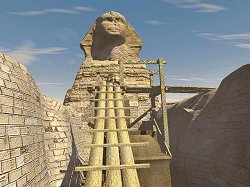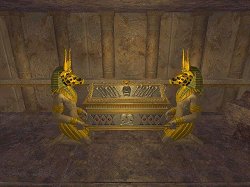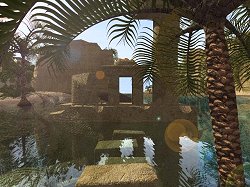|
Riddle of the Sphinx: An Egyptian Adventure
 The wonderful thing about ancient monuments such as the Sphinx and Pyramids at Giza is that they fire our imagination and demand that we speculate upon their origins. Numerous theories have abounded for almost as long as these monuments themselves and now the sciences of geology, climatology and astronomy are combining to suggest a much greater age for the Sphinx than conventional archaeological thinking is prepared to concede or allow.
As old and cherished theories waver under the onslaught of new evidence we seem poised at the cusp of a momentous breakthrough in our understanding of these and other ancient monuments. What if the Sphinx is thousands of years older than the dynasties of the Pharaohs who were supposed to have carved it? And not just a few thousand years, but perhaps ten thousand years? Back to a time when the climate of Egypt was considerably wetter than it is today? The real riddle of the Sphinx beckons us still because it remains unanswered. The wonderful thing about ancient monuments such as the Sphinx and Pyramids at Giza is that they fire our imagination and demand that we speculate upon their origins. Numerous theories have abounded for almost as long as these monuments themselves and now the sciences of geology, climatology and astronomy are combining to suggest a much greater age for the Sphinx than conventional archaeological thinking is prepared to concede or allow.
As old and cherished theories waver under the onslaught of new evidence we seem poised at the cusp of a momentous breakthrough in our understanding of these and other ancient monuments. What if the Sphinx is thousands of years older than the dynasties of the Pharaohs who were supposed to have carved it? And not just a few thousand years, but perhaps ten thousand years? Back to a time when the climate of Egypt was considerably wetter than it is today? The real riddle of the Sphinx beckons us still because it remains unanswered.
The wonderful thing about computer technology in the form of adventure games is that they can thrust us centre-stage into the heart of great mysteries and challenge us to find a solution. Of course the 'solution' on offer in any particular game is that postulated by the creative imagination of the developers influenced, no doubt, by their research but inspired by the enigmatic nature of the monuments themselves.
The multi-talented developers of Riddle of the Sphinx, Jeff and Karen Tobler have obviously put a tremendous amount of research into this project and have incorporated more than one riddle into their game. So I found it surprising that the 'pay-off' solution to the riddle at the end seemed anachronistic. I'm being careful not to give anything away here, as I certainly don't want to spoil it for those of you who haven't played it. Perhaps I missed a clue but the only reason for the particular 'artefact' to be found in the Sphinx seemed to be that it was put there at a later date. It's as though someone decided to steal the Mona Lisa and bury it for safe keeping under the altar stone at Stonehenge. Its presence seemed totally unrelated to the monument and all that had gone before.
Still, I don't wish to dwell on this minor aspect which may not trouble the majority of players. It certainly didn't impinge on my overall enjoyment of the game and I did say there was more than one riddle. The 'real' riddle of the Sphinx is hinted at during the game but remains intact. Who were the ancients who carved this monument and for what purpose? I am hopeful that this line will be pursued in the sequel that was clearly foreshadowed at the end.
 The Riddle of the Sphinx is a first-person perspective adventure game that begins with you arriving by helicopter at the Giza plateau in response to a message from your friend and colleague Sir Gil Blythe Geoffreys. Gil has discovered an ancient papyrus scroll and secret chambers inside the Sphinx and the Great Pyramid. He may also have unleashed a curse that has 'doomed' him so he has sent for you to complete his work. Your first task is to find the scroll that he has left for you. He couldn't leave it lying around as his greedy colleagues would be certain to steal it for their own ends so he has left you clues and messages that will set you upon the right path.
That path leads you into the Great Pyramid where Gil is convinced you will find the key to the riddle of the Sphinx - assuming you survive of course. The Riddle of the Sphinx is a first-person perspective adventure game that begins with you arriving by helicopter at the Giza plateau in response to a message from your friend and colleague Sir Gil Blythe Geoffreys. Gil has discovered an ancient papyrus scroll and secret chambers inside the Sphinx and the Great Pyramid. He may also have unleashed a curse that has 'doomed' him so he has sent for you to complete his work. Your first task is to find the scroll that he has left for you. He couldn't leave it lying around as his greedy colleagues would be certain to steal it for their own ends so he has left you clues and messages that will set you upon the right path.
That path leads you into the Great Pyramid where Gil is convinced you will find the key to the riddle of the Sphinx - assuming you survive of course.
Exploring the pyramid is truly fascinating - both the 'real' structure consisting of unadorned claustrophobic passageways and chambers where the oppressive weight of millions of tons of stone above you is palpable, and the 'imagined' secret chambers with their carvings and paintings fit for a Pharaoh. The painstaking research and attention to detail is readily apparent and contributes to that feeling of 'being there'.
Navigation is fairly straightforward. A pointing finger indicates (generally) when you can move forward. Towards the left and right edges of the screen it will change to a crooked finger indicating you can turn 180 degrees. In a few locations the finger will point left or right allowing you to turn 90 degrees. There is also a 'warp' arrow (similar to that used in Riven) that allows you to quickly zap through long sections that you have previously explored. As you explore you will enter many locations where the navigation switches to a 'virtual reality' mode. Here you can pan around 360 degrees with some vertical movement and these locations frequently represent a 'crossroads' where you can find 'exits' to other areas of the room that may contain something of interest such as an item to pick up or a puzzle to solve.
For the most part the puzzles are interesting and in context and consist largely of finding and using items including scrolls that provide a pictorial clue for what you may need to do. They range from easy to moderately difficult and even the maze shouldn't be too daunting, as long as you recognise the clue it is fairly simple to navigate. Not all clues can be carried around so it is useful to make a note or sketch of anything that looks important, otherwise you might have to backtrack to check them out again. Your inventory appears in the main menu screen, accessed by pressing the space bar, along with options to save, load and quit and make other adjustments to movement etc.
 The graphics are generally very evocative though they do become grainy during the VR scenes. I also noticed the overlay as Quicktime movies cut in, though this may have been peculiar to my installation. Initially I had trouble picking up various pottery vases. A hand appeared suggesting there was more to do though I could do nothing. However, a quick visit to the Quicktime tips on the game's website enabled me to fix the problem. Luckily for me otherwise I would still be stuck inside the pyramid ... what a terrible fate J. I should also point out here that there is now a patch available from the website that fixes other glitches that players have reported. The graphics are generally very evocative though they do become grainy during the VR scenes. I also noticed the overlay as Quicktime movies cut in, though this may have been peculiar to my installation. Initially I had trouble picking up various pottery vases. A hand appeared suggesting there was more to do though I could do nothing. However, a quick visit to the Quicktime tips on the game's website enabled me to fix the problem. Luckily for me otherwise I would still be stuck inside the pyramid ... what a terrible fate J. I should also point out here that there is now a patch available from the website that fixes other glitches that players have reported.
The atmospheric music and sound effects are also very good though I was surprised that the sound of your character yawning upon going to sleep and awakening clearly said you were male when great pains had otherwise been taken not to identify you at all. There are no conversations as such though you must listen to tape recordings left for you at the beginning and 'someone' will talk to you at the end. You do have to listen carefully and I thought both would have benefited by having subtitles.
However, I must say I enjoyed exploring the labyrinthine chambers and puzzling my way through the clues. It is possible to meet a sticky end if you are unwary, but equally it is possible to avoid the traps and pitfalls completely by careful interpretation of the scrolls that you find. Though much of the game takes place in the interior of the pyramid the 'gloom' is relieved by an extended location bathed in brilliant sunshine and you can always return to the plateau if you are feeling claustrophobic. Indeed, it is fascinating just being allowed to wander completely around the Sphinx within its natural enclosure.
Technically, there are a few 'rough edges' with the transition to VR mode being the most noticeable, but overall the game works very well. Once I had fixed my Quicktime problems I found it to be remarkably stable with no crashes or lock-ups even when I flicked to the desktop mid-game to save screenshots.
The Riddle of the Sphinx is an absorbing and satisfying solitary exploration game suitable for all the family to join in and play.
Copyright © Gordon Aplin 2001.
All rights reserved.
System Requirements:
Windows 95/98/ME, Pentium 166MHz (PII 300 MHz Recommended) 32 MB Available RAM (64 MB Recommended) 8x CD-ROM Drive, 14" Display/Thousands of Colors (16-bit)
Macintosh, PowerPC (System 7.5 or better) (G3 Recommended) 32 MB Available RAM, 8x (or faster) CD-ROM Drive, 14" Monitor/Thousands of Colors (16-bit)
|

